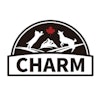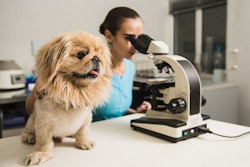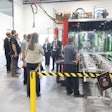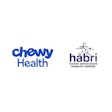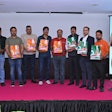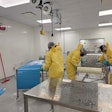Winpak reports consolidated results in US dollars for the fourth quarter of 2021, which ended on December 26, 2021.
Winpak Ltd. manufactures and distributes high-quality packaging materials and related packaging machines. The Company's products are used primarily for the packaging of perishable foods, beverages and in healthcare applications.
Forward-looking statements: Certain statements made in the following report contain forward-looking statements including, but not limited to, statements concerning possible or assumed future results of operations of the Company. Forward-looking statements represent the Company's intentions, plans, expectations and beliefs, and are not guarantees of future performance. Such forward-looking statements represent Winpak's current views based on information as at the date of this report. They involve risks, uncertainties and assumptions and the Company's actual results could differ, which in some cases may be material, from those anticipated in these forward-looking statements. Factors that could cause results to differ from those expected include, but are not limited to: the terms, availability and costs of acquiring raw materials and the ability to pass on price increases to customers; ability to negotiate contracts with new customers or renew existing customer contracts with less favorable terms; timely response to changes in customer product needs and market acceptance of our products; the potential loss of business or increased costs due to customer or vendor consolidation; competitive pressures, including new product development; industry capacity, and changes in competitors' pricing; ability to maintain or increase productivity levels; ability to contain or reduce costs; foreign currency exchange rate fluctuations; changes in governmental regulations, including environmental, health and safety; changes in Canadian and foreign income tax rates, income tax laws and regulations. In addition, factors arising as a result of the Coronavirus (COVID-19) global pandemic that could cause results to differ from those expected include, but are not limited to: potential government actions, changes in consumer behaviors and demand, changes in customer requirements, disruptions of the Company's suppliers and supply chain, availability of personnel and uncertainty about the extent and duration of the pandemic. Unless otherwise required by applicable securities law, Winpak disclaims any intention or obligation to publicly update or revise this information, whether as a result of new information, future events or otherwise. The Company cautions investors not to place undue reliance upon forward-looking statements.
Financial Performance
Net income attributable to equity holders of the Company for the fourth quarter of 2021 amounted to $30.0 million or 46 cents in earnings per share (EPS), surpassing the 2020 corresponding result of $27.3 million or 42 cents per share by 10.2 percent. Significant gains in sales volumes elevated EPS by 4.5 cents, of which 1.5 cents is estimated to be attributed to COVID-19. Gross profit margins led to an expansion in EPS of 4.0 cents. The level of net income attributable to non-controlling interests augmented EPS by a further 0.5 cents. Conversely, foreign exchange lessened EPS by 3.5 cents. In addition, operating expenses and income taxes had a minor unfavorable influence on EPS to the extent of 1.0 cent and 0.5 cents, respectively.
For the year ended December 26, 2021, net income attributable to equity holders of the Company of $103.8 million or $1.60 per share, decreased from the prior year's income of $106.3 million or $1.64 per share by 2.4 percent. Overall, higher sales volumes uplifted EPS by 15.0 cents. Of this amount, it is estimated that COVID-19 accounted for an increase of 3.0 cents while non-COVID-19 related sales growth positively affected EPS by 12.0 cents. Lower gross profit margins were a prominent factor, adversely impacting EPS by 16.0 cents. Higher operating expenses reduced EPS by 2.5 cents. Additionally, the change in net finance expense (income) and foreign exchange each subtracted 2.0 cents from EPS. Income taxes added 3.5 cents to EPS.
Operating Segments and Product Groups
The Company provides three distinct types of packaging technologies: a) flexible packaging, b) rigid packaging and flexible lidding and c) packaging machinery. Each is deemed to be a separate operating segment.
The flexible packaging segment includes the modified atmosphere packaging, specialty films and biaxially oriented nylon product groups. Modified atmosphere packaging extends the shelf life of perishable foods, while at the same time maintains or improves the quality of the product. The packaging is used for a wide range of markets and applications, including fresh and processed meats, poultry, cheese, medical device packaging, high performance pouch applications and high-barrier films for converting applications. Specialty films include a full line of barrier and non-barrier films which are ideal for converting applications such as printing, laminating and bag making, including shrink bags. Biaxially oriented nylon film is stretched by length and width to add stability for further conversion using printing, metalizing or laminating processes and is ideal for food packaging applications such as cheese, fluid and viscous liquids, and industrial applications such as book covers and balloons.
The rigid packaging and flexible lidding segment includes the rigid containers, lidding and specialized printed packaging product groups. Rigid containers include portion control and single-serve containers, as well as plastic sheet, custom and retort trays, which are used for applications such as food, pet food, beverage, dairy, industrial and healthcare. Lidding products are available in die-cut, daisy chain and rollstock formats and are used for applications such as food, dairy, beverage, industrial and healthcare. Specialized printed packaging provides packaging solutions to the pharmaceutical, healthcare, nutraceutical, cosmetic and personal care markets.
Packaging machinery includes a full line of horizontal fill/seal machines for preformed containers and vertical form/fill/seal pouch machines for pumpable liquid and semi-liquid products and certain dry products.
Revenue
COVID-19 has influenced the Company's product groups to varying degrees. Throughout 2021, sales order levels have improved notably with respect to customers that are aligned with the foodservice and hospitality industries. Simultaneously, for customers that serve the retail food market, volumes remained elevated. Relative to 2020, it is estimated that COVID-19 raised fourth quarter sales volumes between 2.5 to 3.5 percent and enhanced 2021 sales volumes between 1.5 to 2.5 percent.
For the second quarter in a row, the Company posted the highest revenue result in its history. Revenue in the fourth quarter of 2021 was $279.1 million, representing an increase of $67.0 millionor 31.6 percent from the fourth quarter of 2020. Volumes advanced an impressive 12.3 percent. The rigid packaging and flexible lidding operating segment volumes grew by 19 percent in the quarter. The extraordinary increase in rigid container volumes stemmed from the new custom pet food tray product launch as well as the large expansion in condiment and snack food container activity. Healthy growth in lidding product group volumes was due to advancements in specialty beverage and retort pet food lidding. Within the flexible packaging operating segment, solid volume growth of 12 percent was realized. For the modified atmosphere packaging product group, exceptional volume growth reflected enhanced demand from customers that participate in the foodservice industry. Also impactful was the onboarding of frozen food business and the gains made with various customers that shifted their flexible packaging sourcing requirements to Winpak due to supply chain challenges that intensified during the latter part of 2021. Packaging machinery recorded a drop in volumes in the quarter as an exceptional number of machines were shipped in the final quarter of 2020. Selling price and mix changes had a significant positive effect on revenue of 18.9 percent as the persistent, sizeable increases in raw material costs during 2021 resulted in higher selling prices to customers. The impact of foreign exchange on revenue was negligible.
For 2021, revenue reached an all-time high of $1,002.0 million, eclipsing the $1 billion threshold for the first time in the Company's history, growing by 17.5 percent from the 2020 level of $852.5 million. Volumes strengthened by 9.7 percent. Within the rigid packaging and flexible lidding operating segment, volumes climbed by 12 percent. The substantial increase in rigid container volumes was a combination of customers' new product offerings, notably pet food trays and dessert containers, and elevated condiment and snack food container shipments. Lidding product group volumes were modestly higher, highlighted by new retort pet food lidding business along with buoyant snack food lidding activity. Sizeable volume growth was realized by the specialized printed packaging product group as new nutraceutical packaging business was secured. The flexible packaging operating segment attained volume growth of 9 percent. In particular, modified atmosphere packaging volumes expanded due to the enhanced demand for meat and cheese packaging. Major customers in both retail and foodservice markets raised their order levels considerably. Additionally, new frozen food packaging business was commercialized mid-year. Biaxially oriented nylon volumes benefitted from the heightened demand of non-food retail customers which was constrained in 2020 with the more restrictive public health orders. Similarly, specialty film volumes accelerated in the current year due to the rebound experienced by medical customers whose business was severely hampered by the pandemic in 2020. Packaging machinery volumes receded by 5 percent as several machines that were scheduled to be shipped towards the end of the year were deferred until early 2022 on account of supply chain delays for components. Compared to 2020, selling price and mix changes had a large favorable effect on revenue of 7.0 percent as the substantial increase in raw material costs throughout 2021 resulted in higher selling prices to customers. Foreign exchange had a minor positive influence of 0.8 percent on revenue.
Gross Profit Margins
Gross profit margins receded to 27.6 percent of revenue in the fourth quarter of 2021 from the 30.8 percent recorded in the same quarter of 2020. However, gross profit increased by 17.6 percent from $65.4 million in the fourth quarter of 2020 to $76.9 million in the current quarter, while sales volumes accelerated by 12.3 percent over the same time frame. The impact was a relative increase in EPS of 4.0 cents. Selling price increases slightly outpaced raw material increases, a reflection of more profitable sales mix and the recovery of the dramatic rise in raw material costs through selling price pass-through adjustments to customers, of which 69 percent of Winpak's business is covered by contractual indexing programs.
For the current year, gross profit margins decreased to 27.4 percent of revenue versus the 2020 level of 30.9 percent. This resulted in an overall contraction in EPS of 16 cents. Raw material costs reached unprecedented levels, escalating to a much a greater extent than the corresponding selling price adjustments, lowering EPS by 27 cents. In accordance with the contractual timing of passing along these raw material cost increases to customers on formal price indexing programs, the average delay is approximately four months and was responsible for this inequity. With the robust expansion in sales volumes, the Company was able to achieve substantial manufacturing cost efficiencies which elevated EPS by 11 cents.
The raw material purchase price index declined by 2 percent from the third quarter of 2021 as polypropylene and polyethylene resins retreated by 15 percent and 5 percent, respectively, from the peaks reached in the previous quarter. In contrast, foil costs increased by 12 percent. From the start of 2021, the index advanced by an incredible 51 percent. The pronounced change in the index over the past 12 months was caused by the sustained, heightened global demand for the Company's key resins and adverse weather events which led to constrained producer supply.
Expenses and Other
Operating expenses in the fourth quarter of 2021, adjusted for foreign exchange, expanded at a greater rate relative to the progression in sales volumes and consequently, lowered EPS by 1.0 cent. Higher freight and distribution costs were the leading factor. Expected credit loss recoveries on trade and other receivables had the opposite effect and were in contrast to the expected credit loss expenses recorded in the fourth quarter of 2020. Foreign exchange lowered EPS by 3.5 cents in the quarter with the overriding component being the significant positive translation differences incurred in the final quarter of 2020 on the revaluation of Canadian dollar monetary assets and liabilities. A slight increase in the effective income tax rate in the final quarter of 2021 diminished EPS by 0.5 cents. A lower proportion of earnings attributable to non-controlling interests added 0.5 cents to EPS.
For the 2021 fiscal year, operating expenses, adjusted for foreign exchange, advanced at a rate of 11.4 percent in comparison to the 9.7 percent acceleration in sales volumes, subtracting 2.5 centsfrom EPS. Heightened freight and distribution costs, in combination with personnel additions to Winpak's salesforce to support strategic market growth initiatives, including the Wiicare healthcare platform with Wipak, Winpak's European sister company, were the key factors leading to the rise in operating expenses. This was somewhat muted by the expected credit loss recoveries realized on trade and other receivables in the current year, a turnaround from the expected credit loss expenses recorded in the prior year. The Company's Canadian dollar transactions were translated at a less advantageous average exchange rate in 2021 and this occurrence was only partially mitigated by the gains realized on foreign exchange forward contracts. Additionally, negative translation differences were recorded on the revaluation of Canadian dollar monetary assets and liabilities in the current year in contrast to the positive differences that were realized in 2020. Overall, foreign exchange reduced EPS by 2.0 cents. Due to the modest decline in the rate of interest earned on the Company's cash and cash equivalent amounts, net finance expense (income) lowered EPS by 2.0 cents. The effective income tax rate dropped by 1.4 percentage points, adding 3.5 cents to EPS.
Capital Resources, Cash Flow and Liquidity
The Company's cash and cash equivalents balance ended the current year at $377.5 million, an increase of $25.2 million from the end of the third quarter. Winpak continued to generate strong cash flows from operating activities before changes in working capital of $50.9 million. Cash was consumed by net working capital additions of $11.9 million. Trade and other receivables grew by $15.0 million, coinciding with the $24.9 million growth in revenue from the immediately preceding quarter. Additionally, inventories expanded by $13.7 million as supply chain challenges lessened and inventory levels returned to targeted levels. Largely a result of the growth in inventories, trade payables and other liabilities advanced by $15.5 million. Cash was utilized for plant and equipment additions of $9.4 million, income tax payments of $2.4 million, dividend payments of $1.5 millionand other items totaling $0.5 million.
For 2021, the cash and cash equivalents balance decreased by $117.9 million. The payment of a special dividend of $159.4 million ($195.0 million Canadian) and regular dividend payments of $6.2 million resulted in the notable reduction in cash. Cash flows generated from operating activities before changes in working capital were sizeable at $186.0 million. The net investment in working capital amounted to $68.2 million. The increases in inventories, trade and other receivables and trade payables and other liabilities each related to the unprecedented rise in raw material costs as well as the healthy growth in sales volumes. Other uses of cash included: plant and equipment additions of $48.3 million, income tax payments of $19.1 million, and other items amounting to $2.7 million. The plant and equipment expenditures included the completion of the Company's biaxially oriented nylon facility expansion and the installation of the related additional extrusion capacity. Furthermore, the new cast co-extrusion line at the modified atmosphere packaging plant was installed and successfully commercialized. The rigid container operation in Sauk Village, Illinois completed the building infrastructure and installation of the initial production equipment for injection molded containers and in-mold labels.
Looking Forward
Winpak enters 2022 with a foundation built for solid sales volume growth and enhanced profitability. In 2021, the Company, along with all of its devoted employees, navigated one of the most challenging years in its history. Winpak successfully managed the effect of the COVID-19 pandemic, dealt with an extremely difficult supply chain environment and faced limited availability of human resources. These matters will be prevalent again in 2022 and could influence the Company's results. However, to the extent possible, Winpak has implemented counter measures to minimize the financial impact and disruptive nature of these issues, ensuring our customers' packaging needs are fully met in an efficient and timely manner. In 2021, raw material procurement relationships with long-term suppliers were leveraged. Additionally, securing alternate sources of raw material supply, expediting incoming shipments and implementing material substitutions where possible were key elements undertaken by Winpak. Furthermore, investments in plant infrastructure and warehousing have been initiated to support the maintenance of higher inventory levels of key raw materials. During the current wave of the pandemic, the health and safety of our employees continues to be the primary focus and additional standard operating procedures have been instituted to minimize the risk of workplace transmission. Even with high levels of community transmission, the Company has been able to maintain the continuity of operations in all of our facilities. Once the current phase of the pandemic subsides, the economy should continue to return to pre-COVID-19 levels. Although the consensus view is that this transition should take hold in the second half of 2022, the precise timing and extent of the economic rebound is difficult to predict. In the coming year, attracting sufficient human resources, in a challenging labor market, will be a top priority. To be recognized as an employer of choice, flexible work arrangements and employee training and development programs will be relied upon and modified as required.
The Company is committed to a transformation towards a carbon-neutral footprint, while providing an unmatched offering of products and services that help protect and extend the shelf life of food and other products. This transition is also vital for our business partners as they move towards the achievement of their sustainable packaging targets. The roadmap to sustainable product offerings is constantly expanding for both rigid and flexible packaging. New technology has been commercialized within the modified atmosphere packaging operations that opens many opportunities for reusable/recycle-ready high-barrier thermoforming films and spouted pouches. Going forward, additional capital resources will be allocated to enhancing and broadening Winpak's technical expertise and capabilities to expand its growing product portfolio of sustainable packaging.
In 2021, sales volumes accelerated by 9.7 percent, the highest annual growth rate achieved by the Company since 2014. Based on current business opportunities and the vibrant North American economy, this momentum should carry forward into 2022. The flexible packaging segment will reap the benefit of new extrusion capacity. The new cast co-extrusion line commercialized in the fourth quarter of 2021 at the modified atmosphere packaging plant will provide the needed capacity for protein and cheese business gains. Additionally, frozen food and spouted pouch packaging will contribute favorably. The new extrusion line at the biaxially oriented nylon facility is slated to be a catalyst for incremental volumes by the second half of 2022. Similarly, robust sales volume growth is expected for the rigid packaging and flexible lidding segment. Both the rigid container and flexible lidding product groups have been awarded further retort pet food and snack food business. With the manufacturing capabilities now in place for injection molded containers and in-mold labels at the Sauk Village, Illinois rigid container site, this endeavor will be a core component of the Company's growth aspirations over the foreseeable future. Due to new pharmaceutical and nutraceutical business, the specialized printed packaging product group will see an uptick in activity in 2022. Subsequent to implementing the Wiicare global healthcare initiative in 2021, new medical packaging opportunities have been secured and the scale of current prospects is promising. Fueled by the substantial order backlog and the greater productive capability of their new facility, the packaging machinery segment should contribute healthy volume growth in the upcoming year.
After rising by 54 percent over the first nine months of 2021, overall resin prices stabilized and started to retreat by the end of 2021 and the majority of the 2021 raw material cost increases have been passed along to customers. Accordingly, gross profit margins began returning to the levels achieved in recent years and are indicative of the Company's optimistic profitability expectations heading into 2022. Current market views are that raw material prices will temporarily rise in the first quarter of 2022 and should then gradually recede over the balance of the year. However, adverse weather conditions and unforeseen supply chain events could put additional upwards pressure on raw material prices and constrain gross profit margins. In addition, resin producers have enacted measures to restrict supply in order to sustain the exceptionally high prices. For all other key cost categories, significant inflationary pressures persisted in 2021, most notably for consumables, freight and distribution, employee compensation and energy expenses. Inflation remains a prime challenge and is not expected to materially subside in 2022. The Company will assess the requirement to pass on these cost increases to its customers in the ensuing year.
Capital expenditures of approximately $60 to $70 million are forecast for 2022. The installation of the new biaxially oriented polyamide (BOPA) line in Winnipeg, Manitoba is nearly complete. Extensive pre-production activities will be undertaken in the first half of 2022 and the line is expected to be fully operational by mid-2022. In the upcoming year, printing and laminating converting capacity will be added to the modified atmosphere packaging facility. As new business is awarded, Winpak is poised to undertake the required building expansions and acquire additional extrusion and converting capacities. The Company remains steadfast with its prime focus being organic growth opportunities, new technologies and expanded product offerings, especially those that promote the core sustainability objectives. Complementary acquisition candidates that align strategically with Winpak's strengths in sophisticated packaging for food, beverage and healthcare applications, providing a satisfactory economic return for shareholders, will be seriously considered and evaluated. During the latter half of 2021, potential acquisition opportunities started to resurface with greater frequency and should accelerate in 2022.


